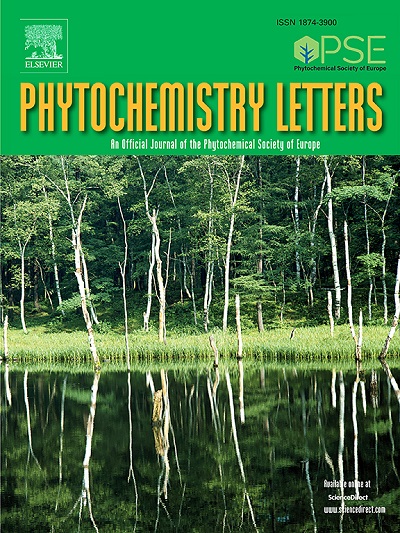上游加工对紫锥菊酊剂化学成分及免疫调节活性的影响
IF 1.4
4区 生物学
Q4 CHEMISTRY, MEDICINAL
引用次数: 0
摘要
紫锥菊(L.)芒草是一种药用植物,因其免疫调节特性而广为人知。人们对如何制备紫荆酊剂以确保其最有利的生物活性缺乏了解。为了解决这一差距,用新鲜或干燥的植物材料制备了24种紫荆酊剂,这些植物材料在收获时切碎(>2000µm)或切碎(500-2000µm),并且是2或3年的。酊剂含有草药或根或两者的组合。采用高效液相色谱法结合1H NMR数据进行主成分分析,确定了酊剂的化学成分。该分析显示,除4种酊剂外,用干燥植物原料(n = 8)制备的酊剂的咖啡酸衍生物浓度显著高于用新鲜植物原料制备的酊剂。以100 µg/mg浓度的酊剂提取物为实验对象,对非刺激和脂多糖(LPS)刺激的永生化骨髓源性巨噬细胞(iBMDM)和THP-1细胞系进行体外免疫调节能力评价。与新鲜植物提取物相比,含有干燥植物提取物的酊剂在lps刺激的iBMDM和THP-1细胞中降低了IL-6的产生,并在更大程度上增加了THP-1细胞中TNF-α的产生。尽管没有咖啡酸衍生物,但许多用新鲜和切碎的植物材料制备的酊剂提取物具有显著的抗炎活性。在酊剂中加入草药可显著抑制iBMDM和THP-1细胞中的IL-6。本研究强调了选择合适的上游加工方法以保证优质紫荆酊剂的生产的重要性。本文章由计算机程序翻译,如有差异,请以英文原文为准。
The effects of upstream processing on the chemical profile and immunomodulating activity of Echinacea purpurea tinctures
Echinacea purpurea (L.) Moench is a medicinal plant that is widely known for its immunomodulating properties. There is a lack of understanding regarding how E. purpurea tinctures should be prepared to ensure the most favourable biological activity. To address this gap, a total of 24 tinctures of E. purpurea were prepared with fresh or dried plant material, that was chopped (>2000 µm) or shredded (500–2000 µm), and that was 2 or 3-years-old at the time of harvest. Tinctures contained herba or radix or a combination of both. The chemical profile of the tinctures was determined using HPLC coupled with a principal component analysis of 1H NMR data. This analysis revealed that tinctures prepared with dried plant material (n = 8) had significantly higher concentrations of caffeic acid derivatives than tinctures prepared with fresh plant material, with the exception of 4 tinctures. The immunomodulating ability of tincture extracts, at a concentration of 100 µg/mg, was evaluated in vitro using non stimulated and lipopolysaccharide (LPS)-stimulated immortalised bone marrow derived macrophages (iBMDM) and THP-1 cell lines. Tincture extracts containing dried plant material reduced IL-6 production in LPS-stimulated iBMDM and THP-1 cells and increased production of TNF-α in THP-1 cells to a greater extent than tincture extracts prepared with fresh plant material. Despite the absence of caffeic acid derivatives, a number of tincture extracts prepared with fresh and shredded plant material had significant anti-inflammatory activity. The inclusion of herba in the tincture was seen to significantly inhibited IL-6 in both iBMDM and THP-1 cells. This study highlights the importance of selecting appropriate upstream processing methods to ensure the production of quality E. purpurea tinctures.
求助全文
通过发布文献求助,成功后即可免费获取论文全文。
去求助
来源期刊

Phytochemistry Letters
生物-生化与分子生物学
CiteScore
3.00
自引率
11.80%
发文量
190
审稿时长
34 days
期刊介绍:
Phytochemistry Letters invites rapid communications on all aspects of natural product research including:
• Structural elucidation of natural products
• Analytical evaluation of herbal medicines
• Clinical efficacy, safety and pharmacovigilance of herbal medicines
• Natural product biosynthesis
• Natural product synthesis and chemical modification
• Natural product metabolism
• Chemical ecology
• Biotechnology
• Bioassay-guided isolation
• Pharmacognosy
• Pharmacology of natural products
• Metabolomics
• Ethnobotany and traditional usage
• Genetics of natural products
Manuscripts that detail the isolation of just one new compound are not substantial enough to be sent out of review and are out of scope. Furthermore, where pharmacology has been performed on one new compound to increase the amount of novel data, the pharmacology must be substantial and/or related to the medicinal use of the producing organism.
 求助内容:
求助内容: 应助结果提醒方式:
应助结果提醒方式:


